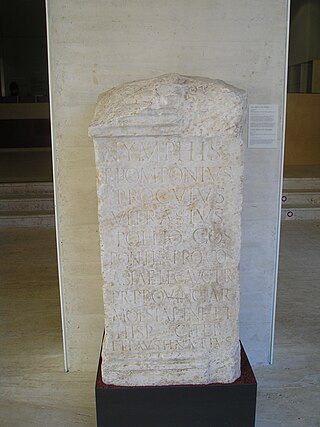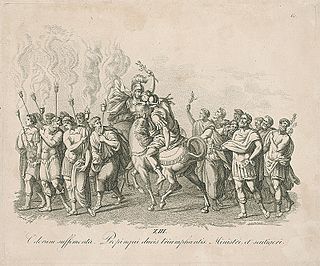Related Research Articles

Gallia Lugdunensis was a province of the Roman Empire in what is now the modern country of France, part of the Celtic territory of Gaul formerly known as Celtica. It is named after its capital Lugdunum, possibly Roman Europe's major city west of Italy, and a major imperial mint. Outside Lugdunum was the Sanctuary of the Three Gauls, where representatives met to celebrate the cult of Rome and Augustus.

Titus Pomponius Proculus Vitrasius Pollio was a Roman senator, who held several imperial appointments during the reign of Marcus Aurelius. He was suffect consul in an undetermined nundinium around 151; he was a consul ordinarius in the year 176 with Marcus Flavius Aper as his colleague.
Servius Cornelius Scipio Salvidienus Orfitus was the name of several Roman men who lived during the early Roman Empire. They were descendants of Orfitus who was adopted by Servius Cornelius Scipio, an otherwise unknown member of the patrician branch of the Cornelii Scipiones.
Titus Sextius Lateranus was a Roman senator active in the second century AD. He was ordinary consul in the year 154 as the colleague of Lucius Verus. Lateranus is also known by a more full name, which has been restored in two different ways: Titus Sextius Lateranus M. Vibius Ovel[lius?...] Secundus L. Vol[usius Torquatus?] Vestinus, or Titus Sextius ... M. Vibius Qui[etus?] Secundus L. Vol[usius Torquatus?] Vestinus.

Gaius Minicius Fundanus was a Roman senator who held several offices in the Emperor's service, and was an acquaintance of Pliny the Younger. He was suffect consul in the nundinium of May to August 107 AD with Titus Vettennius Severus as his colleague. Fundanus is best known as being the recipient of an edict from the emperor Hadrian about conducting trials of Christians in his province.
Gaius Popilius Carus Pedo was a Roman senator who held several offices in the emperor's service during the second century. He was suffect consul in succession to Tiberius Licinius Cassius Cassianus as colleague of Sextus Cocceius Severianus Honorinus until the end of 147.

Lucius Valerius Propinquus was a Roman senator active in the second century AD. He was suffect consul who replaced the ordinary consul Marcus Annius Verus and was the colleague of the other ordinary consul, Gaius Eggius Ambibulus, for the remainder of the first nundinium of 126.
Aulus Ducenius Geminus was a Roman senator active in the first century AD. Geminus is best known as Galba's appointment as Urban prefect of Rome during the Year of Four Emperors.
Gaius Calpurnius Flaccus was a Roman senator of the second century. He was attested suffect consul with Lucius Trebius Germanus as his colleague on 15 December of an undetermined year between 122 and 127. Both Flaccus and Germanus are primarily known from inscriptions.
Publius Cornelius Dexter was a Roman senator and general active during the middle of the second century AD. He was suffect consul for the nundinium July-September 159; the name of his colleague is not known. Dexter is known only from non-literary sources.
Publius Pactumeius Clemens was a Roman senator and jurisconsult active during the first century AD. He was suffect consul for the nundinium April-June 138 as the colleague of Marcus Vindius Verus; according to Ronald Syme, Clemens is the earliest known consul to hold the fasces in absentia. Although he is known mostly through inscriptions, his life provides examples of how patronage operated during contemporary Rome.
Quintus Pompeius Sosius Priscus was a Roman senator active in the mid-second century AD, who held a number of offices in the emperor's service. Priscus served as ordinary consul for the year 149 as the colleague of Lucius Sergius Salvidienus Scipio Orfitus. His life is known entirely from inscriptions.
Lucius Antonius Albus was a Roman senator of the 2nd century AD who occupied a number of offices in the imperial service, as well as serving as suffect consul c. 132. Albus is best known for his tenure as proconsular governor of Asia, when, according to Aelius Aristides, a series of earthquakes struck western Asia Minor.
The gens Salvidiena was a plebeian family at ancient Rome. Members of this gens are first mentioned toward the end of the Republic, and from then to the end of the second century they regularly filled the highest offices of the Roman state.
Quintus Licinius Modestinus [? Sextus] Attius Labeo was a Roman senator, who held a number of imperial appointments during the middle of the second century AD. He was suffect consul in the year 146, following the death of Sextus Erucius Clarus in March, serving until the end of June; his colleague was Gnaeus Claudius Severus Arabianus. He is known entirely from inscriptions.
Quintus Voconius Saxa Fidus was a Roman senator, who was active during middle of the second century. He was suffect consul in the nundinium September-October 146 with Gaius Annianus Verus as his colleague. He is known almost entirely from inscriptions; Voconius is mentioned once in Ulpian's Liber octavus de officio proconsulis.

Titus Caesernius Statianus was a Roman senator who held a number of appointments in the Imperial service during the reigns of Hadrian and Antoninus Pius. He was suffect consul in the nundinium of September-October 141; his colleague's name is not known. His full name is Titus Caesernius Statius Quinctius Statianus Memmius Macrinus.
Quintus Caecilius Marcellus Dentilianus was a Roman senator, who held several imperial appointments during the reign of Antoninus Pius. He was suffect consul in an undetermined nundinium around AD 150. He is known entirely from inscriptions.
Titus Haterius Nepos was a Roman senator and general, who held several imperial appointments during the reign of Hadrian. He was suffect consul in the year AD 134, immediately succeeding Lucius Julius Ursus Servianus as the colleague of Titus Vibius Varus. According to an inscription found in Fulginiae in Umbria, surmised to be his home town, he received triumphal ornaments for an unspecified military victory, as well as attesting his full name is Titus Haterius Nepos Atinas Probus Publicius Matenianus.
References
- ↑ CIL XIII, 1802
- ↑ Syme, "A Dozen Early Priesthoods", Zeitschrift für Papyrologie und Epigraphik , 77 (1989), p. 252
- ↑ Syme, "Dozen Early Priesthoods", p. 253
- ↑ CIL II, 2959
- ↑ Eck, "Jahres- und Provinzialfasten der senatorischen Statthalter von 69/70 bis 138/139", Chiron , 13 (1983), p. 198
- ↑ CIL XVI, 80
- ↑ Alföldy, Konsulat und Senatorenstand unter der Antoninen (Bonn: Rudolf Habelt Verlag, 1977), p. 212